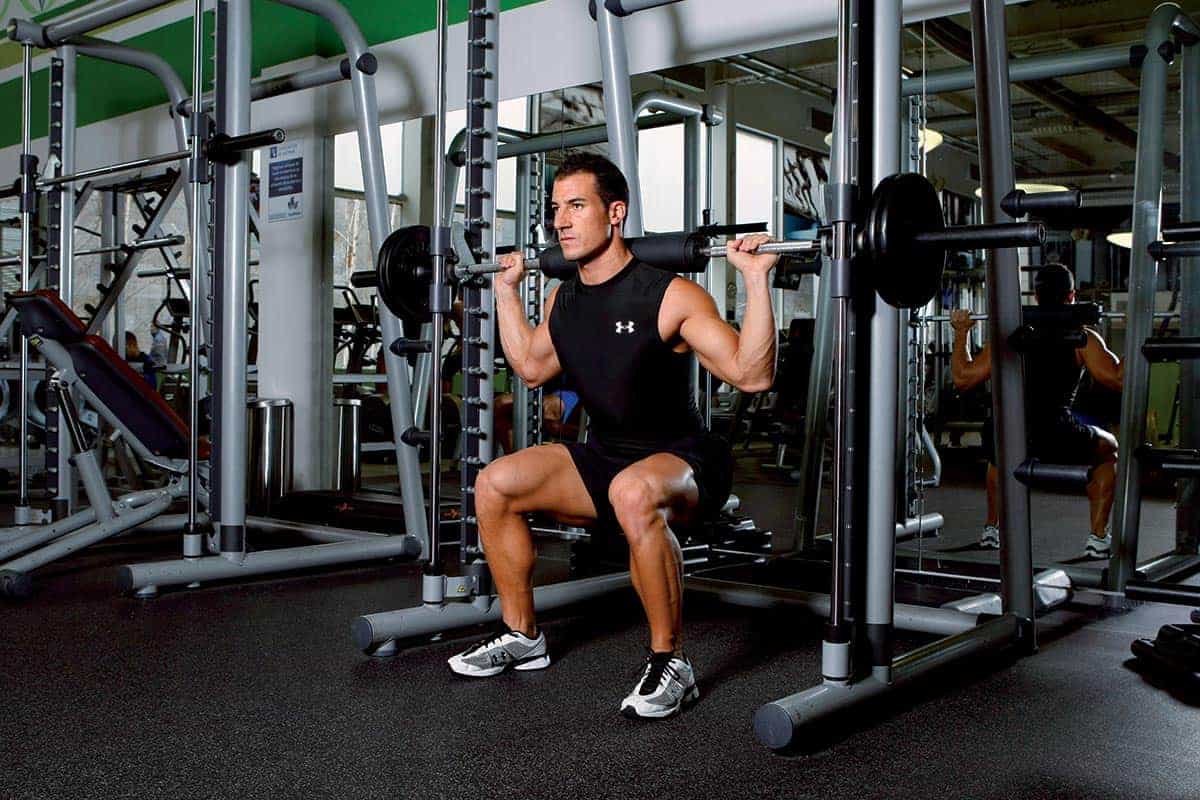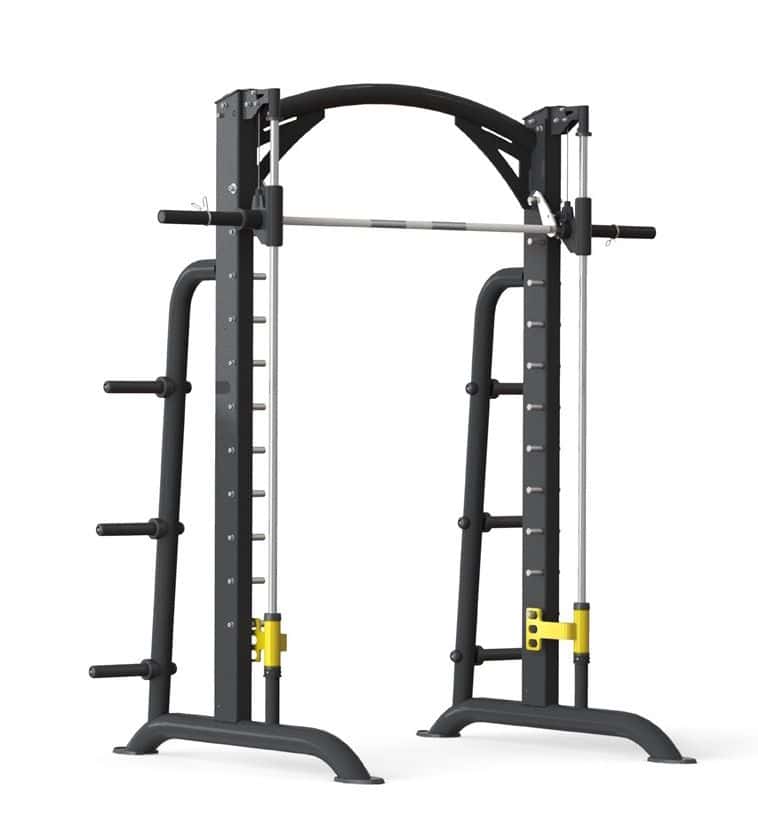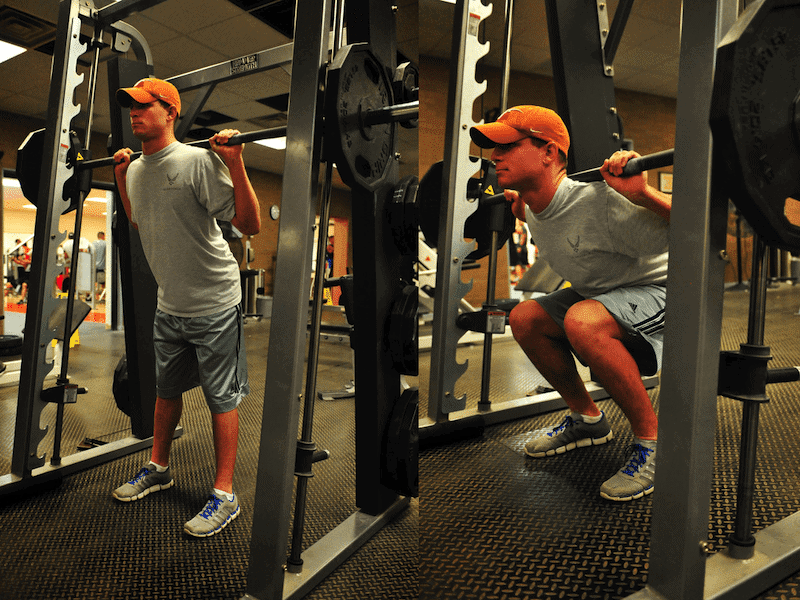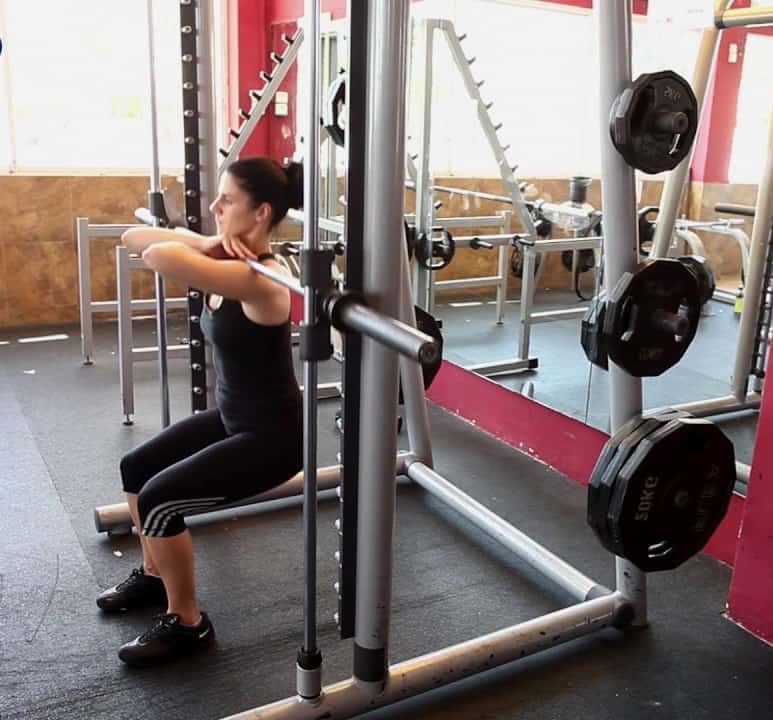In this article, we will analyze the Smith machine squat in detail. For this, we will provide a guide explaining how to perform it, its main benefits, its disadvantages, and what the scientific evidence says about it.
What is the Smith machine squat?
The squat is one of the most popular exercises in general fitness. Whether to improve sports performance, achieve a better quality of life, or for aesthetic reasons, it is always present in training programs as the main exercise for the lower body.
In recent years, variations have been sought to perform the squat, in addition to the classic execution with a barbell. Among them, we highlight: with dumbbells, kettlebell, medicine ball, and even without external load (that is, with body weight) to name a few.
On this occasion, we will focus on the Smith machine squat, a variant widely used these days.
What is a Smith machine?
When we talk about the Smith machine (also known as Smith), we refer to a gym machine or apparatus used to perform a compound exercise (that is, those that involve large muscle groups like the flat bench press or lat pulldowns).
In turn, each rail has a hook that serves to safely place the bar.
Smith machine squat
As we mentioned earlier, the Smith machine allows for compound exercises. Among them, the squat stands out. Thus, we will analyze how to perform the Smith machine squat.
What type of squat can we do? Whether the classic Back squat (squat with the bar behind) or the Front squat (squat with the bar in front) can be performed without problems, as the Smith machine adapts perfectly to both variants.
Next, we will provide a brief technical description of both squats.
How to do the Smith machine squat?
Next, we will see the technical execution of the Smith machine squat:
- Starting position: Stand inside the Smith machine, with the bar resting on your shoulders. Your feet should be shoulder-width apart and slightly turned outwards. The bar should be at the appropriate height so you can lift it easily.
- Perform the squat: Unlock the bar by lowering it slightly and then turning the locking device. Then, lower your body as if you were going to sit, keeping your back straight and knees in line with your feet. Try to lower until your thighs are parallel to the ground.
- Rise back up: Push up from your heels, keeping your back straight, until you are standing again.
- Repeat: Perform several repetitions of this movement, depending on your fitness level and training goals.
Always remember to warm up before starting any exercise routine and maintain good posture throughout the movement to avoid injuries. If you are unsure of your form, it is a good idea to seek advice from a personal trainer or someone experienced in weightlifting.
Back squat
- Adjust the height of the bar so that we can start and finish comfortably, without the need to stand on “tiptoe”.
- Grip the bar with a grip slightly wider than shoulder-width, and place it on the upper part of the back.
- The feet should be shoulder-width apart, with the toes slightly turned outwards.
- Descend keeping the back in a neutral position, with the hips back (in flexion) and then flex the knees.
- Recover (raise the body) to the starting position maintaining the same movement pattern.
Front squat
- Adjust the height of the bar so that we can start and finish comfortably, without the need to stand on “tiptoe”.
- Grip the bar with a grip slightly wider than shoulder-width, and then place them so that we can support the bar on the upper part of the body.
- The feet should be shoulder-width apart, with the toes slightly turned outwards.
- Descend keeping the back in a neutral position, with the hips back (in flexion) and then flex the knees.
- Recover (raise the body) to the starting position maintaining the same movement pattern.
Advantages/benefits of the Smith machine squat
- It is highly recommended for beginners, untrained individuals, and people returning after an injury or a period of inactivity as it is a safe machine with a guided movement.
- It involves less work of the stabilizing muscles, mainly those of the trunk, responsible for supporting the spine.
- In relation to the previous point, it provides more stability due to the fixed vertical path of the bar, which translates into a greater sense of security for performing the exercise.
- It allows for more localized work, making it more viable for hypertrophy.
- In general, the Smith machine squat is often used to focus work on the quadriceps.
Disadvantages of the Smith machine squat
- Due to its linear path, it does not transfer to a sports technical gesture so the Smith machine squat would not be recommended for athletes.
- It presents less muscle activation compared to the free squat, mainly because balance is guaranteed in the machine.
- It provides less proprioceptive information, in relation to the previous point.
- It has less room for improvement, like all fitness machines.
What does science say?
Some researchers have conducted several studies on the effectiveness of the Smith machine squat. For the analysis that concerns us, we will focus only on the research that focused solely on this type of squat, as several of the mentioned studies analyzed different types of compound exercises in the same test.
Following this line, we highlight three types of research.
In 2005, Cotterman and team conducted a study in which they compared muscle force production in a classic squat, using a Smith machine and a barbell (free weights).
The researchers found a significant difference in 1 RM squat in favor of the Smith machine compared to free weights (2).
That same year (2005), Anderson & Behm conducted another study in which they compared the degree of muscle activation between the Smith machine squat and the free squat but performed on unstable surfaces.
In it, they determined greater muscle activation of the vastus lateralis and biceps femoris using the Smith machine, while in free squats greater activation was achieved in the soleus, abdominals, and spinal erectors (1).
The last study we will describe dates from 2016, in which Luebbers & Fry sought to determine if there were differences between the Smith machine squat and free squats for the Kansas test (squat jumps).
Why choose the Smith machine squat?
The Smith machine squat is an excellent option for those looking for a safe and effective way to strengthen the leg and glute muscles.
Effective muscle strengthening
As we have mentioned, the Smith machine squat is especially effective for working the leg and glute muscles. If your goal is to strengthen these muscles, this exercise can be a great addition to your training routine.
Greater safety
The safety provided by the Smith machine can be a great benefit for those new to the gym or who have concerns about injuries.
By limiting movement to a single axis, the Smith machine reduces the risk of injury and allows for greater control over the exercise.
|
⚠ |
Reasons to choose |
Details |
|---|---|---|
| 1 | Effective muscle strengthening | Great focus on legs and glutes |
| 2 | Greater safety | Reduces the risk of injuries |
What muscles do we work on the Smith machine?
The Smith machine squat is a compound exercise that works several muscle groups at once. Here are the main muscles worked with this exercise:
- Quadriceps: They are the main muscles used in squats.
- Glutes: The glutes also play an important role in the squat movement.
- Hamstrings: These muscles in the back of your thighs are also worked during squats.
- Hip muscles: The hip muscles, including the abductors and adductors, are used to stabilize the body during squats.
- Spinal erectors: These muscles along your spine help keep your back straight during the squat.
- Abdominals and obliques: Although not the main target of squats, these muscles are also activated to stabilize the trunk during the exercise.
Remember that you should always maintain good form when doing squats to prevent injuries. This includes keeping your back straight, not allowing your knees to go past your toes, and descending until your thighs are parallel to the ground or slightly below.
Conclusions
Is the Smith machine squat better? Or is the free squat better? The answer is, it depends on the training goal, as well as the interests and limitations of the person.
The Smith machine squat is a recommended exercise for beginners, untrained individuals, and people returning after an injury or a period of inactivity.
It is not recommended for athletes, as the possibility of transfer to a sports technical gesture is scarce or null.
Podcast “Smith machine squat”: Play in new window |
Bibliographic references
- Anderson, K., & Behm, D. G. (2005). Trunk muscle activity increases with unstable squat movements. Canadian Journal of Applied Physiology, 30(1), 33-45.
- Cotterman, M. L., Darby, L. A., & Skelly, W. A. (2005). Comparison of muscle force production using the Smith machine and free weights for bench press and squat exercises. Journal of Strength and Conditioning Research, 19(1), 169
- Luebbers, P. E., & Fry, A. C. (2016). The Kansas Squat Test Modality Comparison: Free Weights vs. Smith Machine. The Journal of Strength & Conditioning Research, 30(8), 2186-2193.
- Rubais, B. (2023). Squat and muscle activation. Available at https://mundoentrenamiento.com/sentadilla-activacion-muscular/
- Sánchez, P. (2020). Smith machine or multipower. Available at https://mundoentrenamiento.com/maquina-smith-o-multipower/





